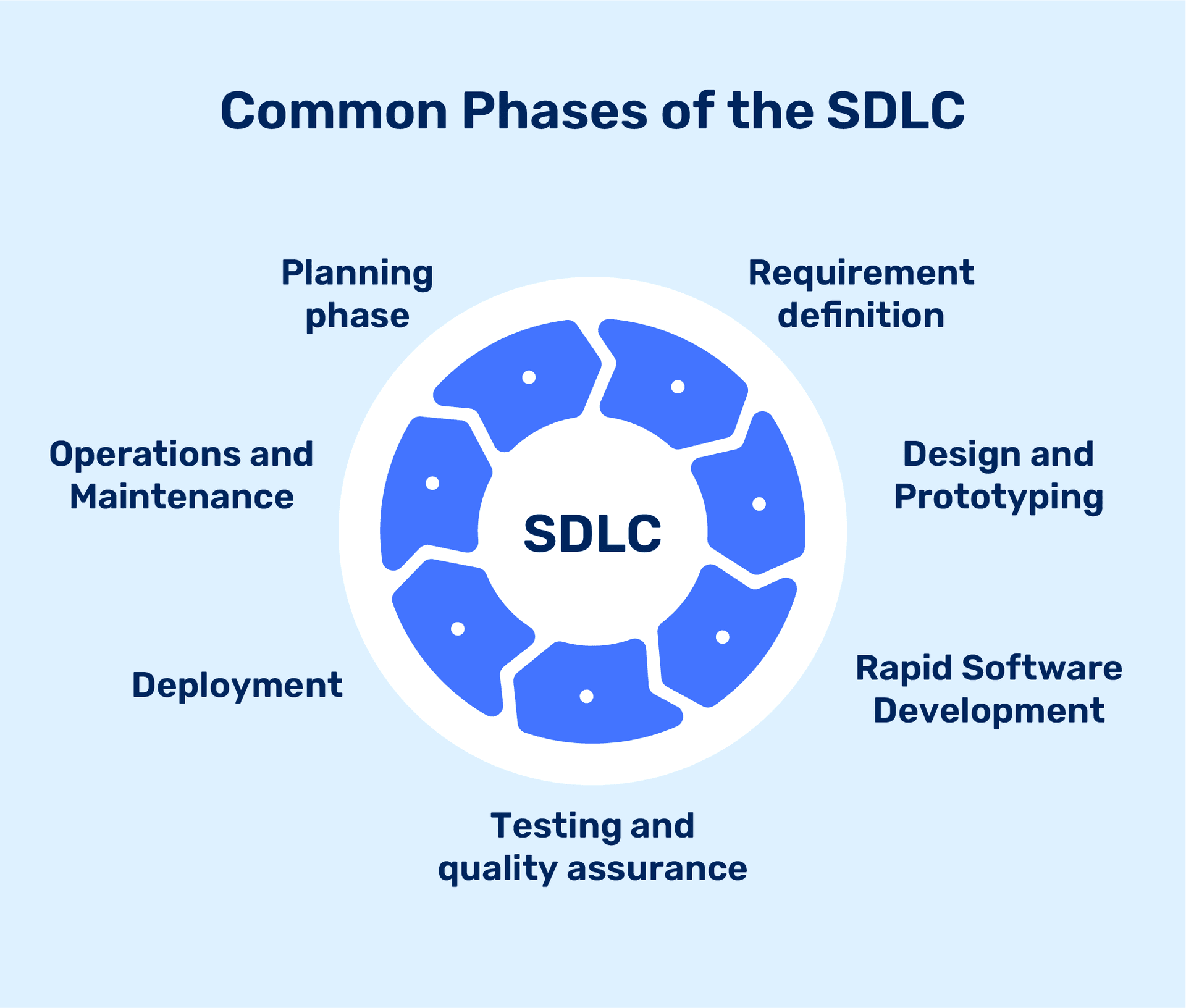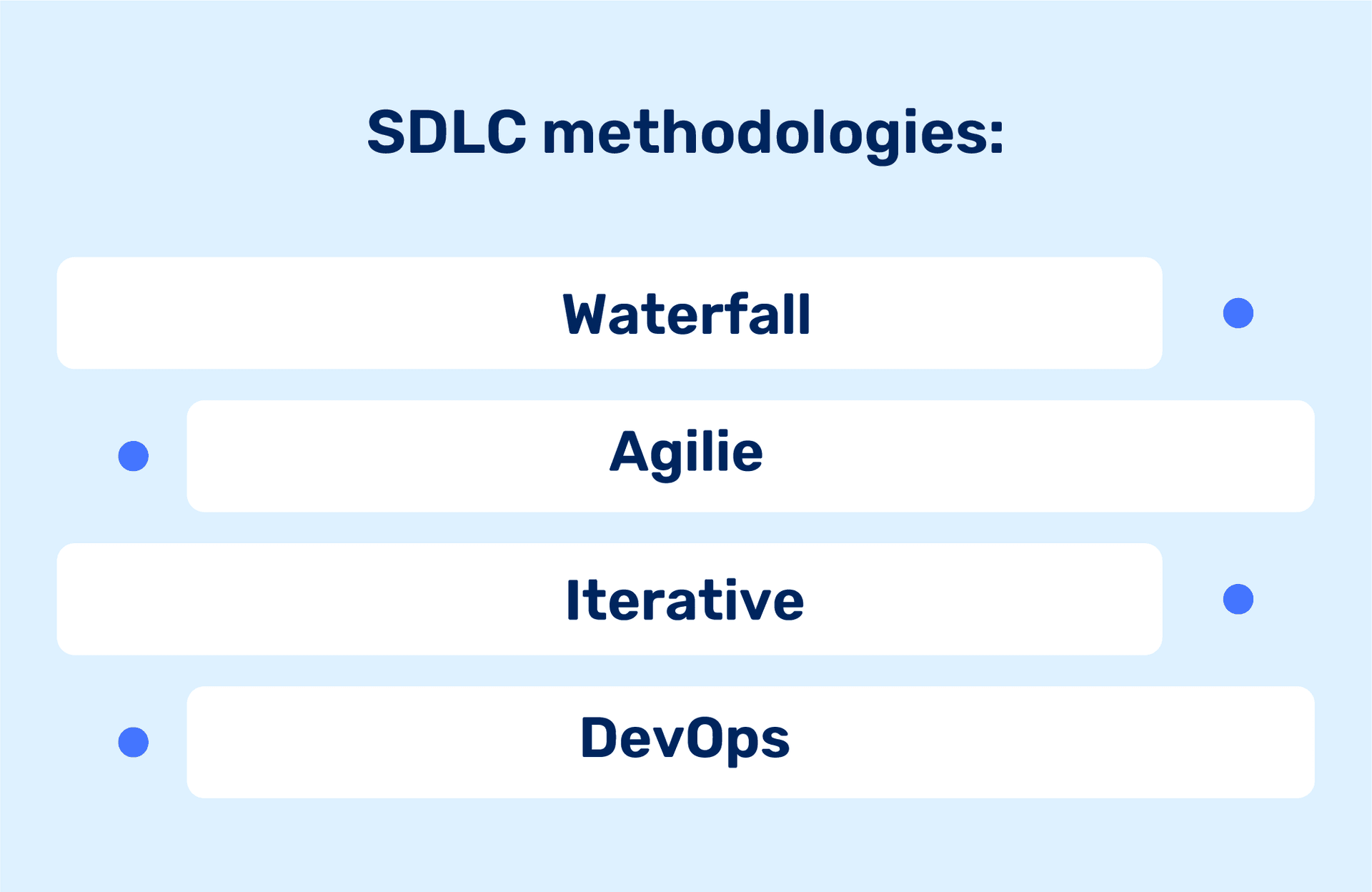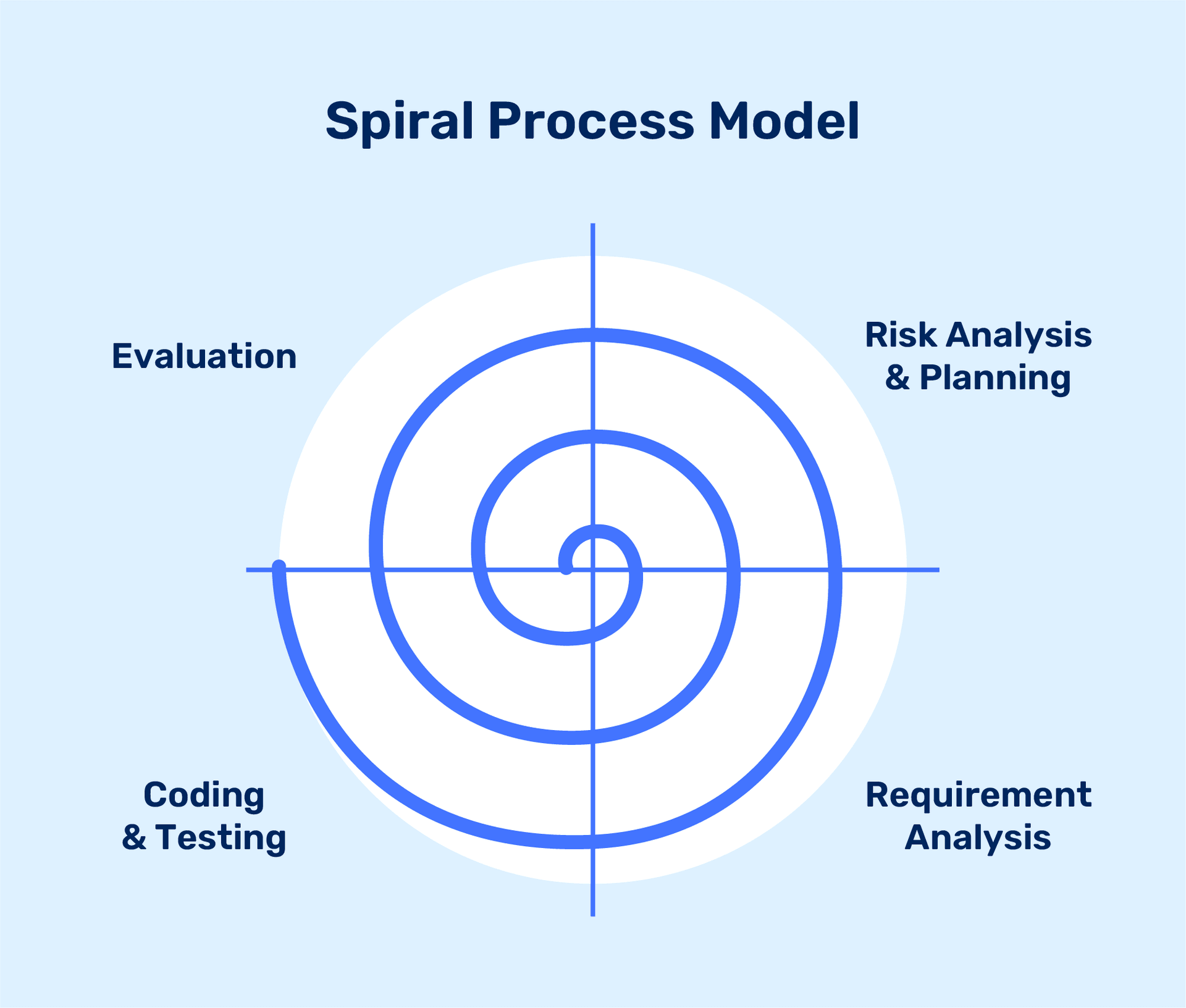SDLC is a process that consists of a detailed plan that describes all the details regarding the development, maintenance, and replacement/change of specific software. It is a methodology used to improve the quality of software as well as improve the overall development process.
System/Software Development Life Cycle, SDLC - represents several stages (or phases) that any software goes through. In essence, it is a detailed plan showing how to develop software, maintain it, change it, and improve it.
The importance of the SDLC cannot be overstated, as it provides a framework for developers to follow, ensuring that all aspects of software development are addressed, from initial planning and requirements gathering to post-release maintenance and support. By following the SDLC, software development teams can minimize errors and defects, ensure consistency, and improve overall quality.
As software continues to play an increasingly important role in our lives, it is essential that we have a well-defined and efficient process for its development. The SDLC provides just such a process, allowing software development teams to work collaboratively and efficiently, resulting in high-quality software applications that meet the needs of users and organizations alike.
What Is the Software Development Life Cycle?
To quote the author of the book Managing Information Technology Projects, James Taylor, "the life cycle of a project covers all the activities of a project." The task of software development is to fulfill the requirements of the product. If you want to learn how to create and release a high-quality software project, you have to follow a plan. According to Taylor, your goal should be a comprehensive analysis of the activities of the project and control of each stage of its development. The right framework will help direct your workflow in the right direction.
Common Phases of the SDLC
In general, SDLC is such a closed loop, in which each stage affects the actions in the subsequent ones and provides promising indications for the future. To answer specific questions and ensure consistency in your development process, there are 7 steps to trying to influence each other effectively and consistently.

1. Planning phase
Planning includes the question "What do we want?". At this stage, the team determines the requirements for the new software and also analyzes the costs.
Also, it details risks and provides sub-plans to mitigate those risks. In this step, a software requirements specification document is created. Planning related to quality assurance and related risks is also carried out in the early stages. Various technical approaches are explored and used for the successful implementation of the project. Development of a fintech app, specific guidelines must be followed to meet the customer’s needs without violating the laws and compliance regulation.
2. Requirement definition
The next step is to define the requirements for the product clearly. Approval is taken from the client or by market analysis. All of this is usually done through the SRS (Software Requirements Specification) document, which contains all the requirements of the project and is designed and developed during the life cycle of the project.
The definition phase of the SDLC is the point where you take all the approved requirements and document them. (Documentation will be a constant, iterative phase of the SDLC. You must document everything you do so you know what you did, how you did it, and when you did it.) This helps your team make sure they are on the right track before they start working on a project.
3. Design and Prototyping
By this stage, you should already know the product requirements and generally understand what you want, and before you start writing code, this understanding should be enough to answer the following question: “How will we achieve our goals?” In other words, you need to understand what you are optimizing and design accordingly. Operation, training, and maintenance plans will all be drawn up so that developers know what they need to do throughout the next stages.
Let's say you want to create a secure, high-performance, efficient, and load-bearing application. Which of these four principles is most important to you? Why? Do the stakeholders from the first stage agree with this? It is important to ensure the approval of all participants.
After the design phase, you can make changes in terms of time, resources spent will steadily increase, as well as all sorts of small factors will gradually accumulate. In this phase, it is recommended to consider several key design elements to make final design decisions: operational excellence, safety, reliability, performance efficiency, and cost optimization.
4. Rapid Software Development
During the Rapid Software Development phase, you want to produce results, or more specifically, you need to be prone to action and create a prototype or system that others can test. At this stage, your task is to gain the trust of stakeholders by embodying the developer's mindset. It is critical to follow the first three steps when starting development to meet expectations.
5. Testing and quality assurance
The next step in the software development lifecycle is to check "have we got what we want?" or the testing phase. At this stage, you check for defects and deficiencies. The systems integration test function is to ensure that the developed systems meet all the technical requirements. Later, after discovery, you try to resolve all issues until the product meets current specifications.
6. Deployment
Take your product and use it. Invite stakeholders from the first stage to use your product in natural conditions, and start tracking sales engagement. You have to listen to your user because feedback through surveys and recommendations will help you return to the first phase and start collecting new requirements. During this phase, training is conducted and the software app is deployed at pilot websites, initially followed by a complete rollout.
7. Operations and Maintenance
The maintenance phase of the SDLC starts after the product is in full operation. Maintenance can include software upgrades, repairs, and fixing of the software if it breaks.
Applications often need to be upgraded or integrated with new systems the customer deploys. It is necessary to provide additional testing of the software or version upgrades. During the maintenance phase, errors or defects may occur, so it would require repairs during additional testing of the software. The performance of the software is also included during the maintenance phase.
SDLC Models & Methodologies
SDLC is often associated with development methodologies in the production environment. There are many of them. The appropriate one is selected based on the scale of the project, the nature of the requirements for the finished product, the stability of the technologies used, and the availability of the necessary resources, taking into account a number of other factors.

Waterfall
The waterfall model is about the phenomenon of how to complete one phase before the start of a new phase of development so that there is no overlap of phases. In the field of software development, the waterfall model was first used as an SDLC approach. This model means that every phase is designed to perform certain actions in the SDLC.
Agile
Agile software development is an agile approach to software development that is often used in small teams and large organizations. In the linked article, you can clarify the differences between SDLC vs Agile. Agile work process is divided into iterations - short cycles of two to three weeks. Each cycle solves a series of tasks. At the end of each iteration, the team analyzes the results and reprioritizes for the next iteration. As a result, for each cycle, a mini-product or a separate part is created, ready for independent launch.
Iterative
The iterative model is the epitome of repetition. Instead of starting with fully known requirements, project teams implement a set of software requirements, then test, evaluate, and define further requirements. At each stage or iteration, a new version of the software is created. Rinse and repeat until the entire system is ready.
The advantages of the iterative model over other common SDLC methodologies are that it creates a working version of the project early in the process and reduces the cost of implementing changes. One downside: repetitive processes can quickly consume resources.
DevOps
The DevOps methodology is a relative newcomer to the SDLC scene. It emerged from two trends: the application of Agile and Lean practices to operations and a general shift in business towards understanding the value of collaboration between developers and operations personnel at all stages of the SDLC process. In the DevOps model, development and management teams work closely together, and sometimes as a team, to accelerate innovation and roll out better, more reliable software products and features. Product updates are small but frequent. Discipline, continuous feedback and process improvement, and manual automation of development processes are all hallmarks of the DevOps model.
Other Models
The following models are currently in use:
-
V-model. Based on the Waterfall. This SDLC model implies quality control at each stage. Suitable for projects where errors can be fatal, where accuracy in meeting requirements is critical.

-
The evolutionary prototyping model. Again, the basis is a Waterfall. The necessary improvements to the project are immediately made based on the feedback of the client (customer). Several prototypes are created, one of which is eventually finalized and sent into production.

-
Spiral. Includes the features of the previous ones. Used for complex, large projects with frequent releases, suitable for software with unclear requirements.

-
Flexible methodologies. There are more than 50 of them. And many, again, may include the features discussed above.
Considering that many models used in the development life cycle contain elements of the Waterfall model, it is advisable to take it as a basis when considering security issues.
Benefits of SDLC
In the first, second, and third stages, business requirements for the product are formed, the wishes and needs of users are taken into account, and the boundaries of the project are determined. Specialists from various fields are involved in the work (marketing, sales, support, and so on). As a result of all these efforts, answers to the questions should appear: “What problems should the software solve?”, “What exactly (what product) needs to be done?”
At the same time, security issues should also be considered at this stage, in particular with regard to identification, authentication, registration of information security events, protection of IS incidents, and control of the completeness, accuracy, and correctness of the processed data. This is done through threat assessment, attack surface analysis, security requirements definition, and risk analysis.
From the SDLC development stage to application testing, security is ensured by:
-
applying secure programming practices,
-
conducting autotests,
-
dynamic code analysis,
-
organization of pentests,
-
functional testing,
-
protocol testing,
-
monitoring, and incident response (after deployment, during operations).

Also, a fairly common tool for ensuring secure software development, which can be used at all stages (starting from the fourth in this case), is static application analysis (SAST). It comes down to code analysis without the need to run the program, which means it is guaranteed to be suitable for development, testing, deployment, and operations.
Static code analysis is implemented using a special tool - SAST analyzer. This technology allows:
-
Detect vulnerabilities. And not only in the "own" files of the app but also in libraries and third-party components that are used during development.
-
Find undeclared capabilities (NDV) in software.
Software Configuration Management (SCM) is a process to systematically manage, organize, and control the changes in documents, code, and other entities during the Software Development Life Cycle. The primary goal is to increase productivity with minimal mistakes.
With the addition of security measures to each stage, we can talk about the transformation of SDLC into SSDLC. This is the Secure Software development lifecycle. This approach is becoming more and more popular because implementing security measures throughout all stages of the life cycle is good practice that saves a lot of time.
FAQs
What is Agile SDLC?
The Agile SDLC model is a combination of iterative and incremental process models with a focus on process agility and customer satisfaction through the rapid delivery of a working software product. Agile Methods breaks down a product into small incremental builds. These builds are provided in iterations. Each iteration typically lasts one to three weeks. Each iteration includes cross-functional teams working simultaneously in different areas, such as:
-
planning
-
requirements analysis
-
design
-
coding
-
unit testing and
-
acceptance testing.
At the end of the iteration, the work product is displayed to the client and important stakeholders.
Why is the Discovery stage an important phase of SDLC?
Discovery occurs at the pre-sale stage when the project has not yet been taken into work. Emphasis on analysis, evaluation, project planning, and preparation of a technical and commercial proposal to the client. According to the results of this type, it is possible that the client will refuse the project altogether (since the received terms and cost will not satisfy him) or decide to compare your estimate with the cost estimates of other contractors.
1. How does it affect the planning of SDLC?
It can help overcome the lack of understanding of the target audience, inability to beat the competition, and product mistiming, increasing the degree of the product’s success. Mistakes made at the initial stage of the development process are the most difficult to correct in the future. That’s why the goal of the Discovery phase is to prevent fatal errors.
2. Does it help to define the requirements?
The Discovery phase is the stage in which the process of collecting and analyzing data is carried out to determine the goals, potential, and limitations of the project. This stage focuses on planning, launching new products, or improving existing solutions. The role of the Discovery phase is to eliminate unforeseen circumstances so that projects are implemented on time and within budget, and customers receive the expected financial result.
3. Could UX wireframes confirm the business idea?
A wireframe is the first-phase version of a site that helps to adjust design plans and confirm the business ideas, so changing your plans becomes easier.
4. Does technical research save development time in the future?
Technical research is important for businesses, as it provides knowledge and insights that leads to improvements to existing processes where efficiency can be increased and costs reduced.
Instruments for effective work in SDLC
-
Atlassian products like Jira & Confluence
-
Meeting & notes
-
Delivery reporting & planning
These tools are very flexible and can be used by teams that are involved both in Agile and Waterfall methodologies. They are customizable and can track all sorts of work in the SDDL, including initiatives, epics, stories, and tasks, as well as other issues specific to the team.
Why is SDLC important?
SDLC provides an effective framework and method to develop software apps. It involves effectively planning before starting the actual development. Developers with the help of SDLC can analyze the requirements. Unnecessary costs during development are reduced.
Who is involved in SDLC?
The three main roles in the SDLC are product owner, project manager, who is team representative, and team lead, who focuses on technical implementation. And, of course, developers, testers, designers, and management team
What is the most important phase of SDLC?
All SDLC phases are valued equally. But, many software developers suggest that the requirement definition and analysis stage is the most important aspect of SDLC. This is when the team begins to understand what the stakeholders expect from the project.